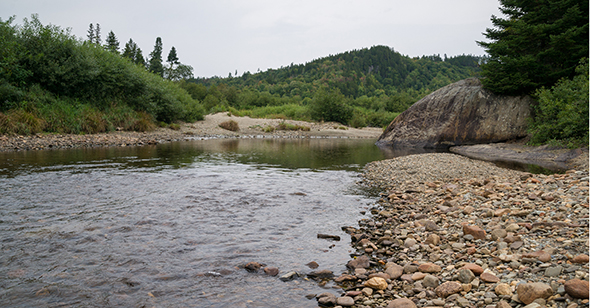
- About
- Physical Education
- Intramurals
- Club Sports
- Fitness
- Recreation
Back to Top Nav
Back to Top Nav
Back to Top Nav
Back to Top Nav
Back to Top Nav
About 140 miles northeast of Hanover, in the north country of New Hampshire, lies Dartmouth’s massive Second College Grant. While the Grant clearly offers fewer cultural events than Hanover, the rugged wilderness provides many unique research and recreational opportunities for Dartmouth students.

The Second College Grant was presented to Dartmouth by the State of New Hampshire in 1807 and is used for research, recreation, and sustainable logging. (photo by Eli Burakian ’00)
Matt Ayres, professor of biology, says the Grant is a “jewel of Dartmouth” that “provides a natural ecological laboratory that inspires and challenges our biology students.” Ayres says students use the almost 42 square miles of wilderness to do research. One ongoing dissertation project measures the effects of atmospheric climate change on stream temperature and ecology. For her senior thesis, Suzanne Kelson ’12 studied the genetic makeup of brook trout in the Grant.
“The Grant has great value as a study site for ecological research,” says Kelson. “The pristine, undammed Swift Diamond and Dead Diamond rivers host a complex system of life, perhaps one of the remaining pristine aquatic systems in the Northeast.”
Andrew Friedland, the Richard and Jane Pearl Professor in Environmental Studies, says there are many features of the Grant that make it a valuable teaching tool. “It is a vast, forested landscape that is useful for studying ecosystem processes,” Friedland says.
"It has a diverse history of land use, mostly in the form of logging, that can be used to understand the effects of logging on forests.”
The land was presented to Dartmouth by the State of New Hampshire in 1807. Dartmouth oversees logging on the land to offset maintenance costs of the Grant. Dartmouth tries to make timber production sustainable and maintain a healthy ecosystem on the land—overseers make efforts to protect soil, limit pesticide use, monitor wildlife habitats, and ensure that the trees are healthy. Kevin Evans, director of Woodland Operations, says, “We cut no more wood than we grow.”
The terrain of the Grant, which is north of the White Mountains, features densely forested rolling hills, rock overhangs, and rushing streams. Wildlife that inhabits Grant land includes moose, bears, owls, woodcocks, martens, and possibly lynx.
Students use the Grant for a variety of recreational activities, too, such as canoeing, cross-country skiing, mountain biking, hunting, and fishing. First-year trips often travel to the Grant, staying in some of the 11 cabins operated by Dartmouth.
John Boger ’13, who has served as co-president of the Bait and Bullet Club, helped organize an annual fly-fishing trip in springtime and a joint student/alumni hunting trip in the fall. “I absolutely love the Grant,” Boger says. “Spending time there has been one of the best parts of my Dartmouth experience.”
The Grant is private property; the entrance is gated and only Dartmouth students, alumni, or employees have vehicular access to the land and can use the cabins. Non-Dartmouth visitors are allowed to stay in the cabins if a Dartmouth community member accompanies them.
One non-Dartmouth visitor in the 1950s happened to be the President of the United States. Dwight D. Eisenhower, who spoke at Dartmouth’s 1953 Commencement, was making a tour of New England in 1955. Arrangements had been made to have Eisenhower visit the Grant for lunch. Knowing there needed to be lots of food for the President’s entourage—which included congressmen, secret service agents, and reporters—Dartmouth President John Sloan Dickey ’29 directed members of the Dartmouth Outing Club (DOC) to fish the Grant’s streams all day to catch the meal. When Eisenhower arrived, he was greeted by Dickey and DOC members, who presented him with membership in the club—and fish for lunch. The gathering was speculated to be the largest ever on the Grant. From recreation to research—and even a bit of presidential history—the Grant provides tremendous resources to students.
“Whether you are conducting research or there for the scenery,” says Justin Richardson, a PhD student in the Environmental Studies program, “it is an amazing location.”